Throughout history, Mars, the Red Planet, has been the most intriguing planet. It shines in the night sky as a bright reddish-orange star, and it appears sometimes to follow an erratic retrograde (backward) path among the stars and planets. These distinctive characteristics inspired a frightful character in many of the ancient mythologies.
Fig (1) Mars the Red Planet as imaged by the Viking spacecraft.
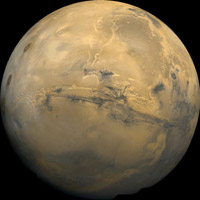
Credit NASA-NSSDC
The ancient Egyptians named Mars Hor Desher, which means "The Red Horus", and Horakhty, which is one of the names of the Great Sphinx. In Greek and Roman mythologies, Mars was the god of war.
Fig (2) Mars, Venus and the Moon Photographed above the Mighty Pyramids of Egypt
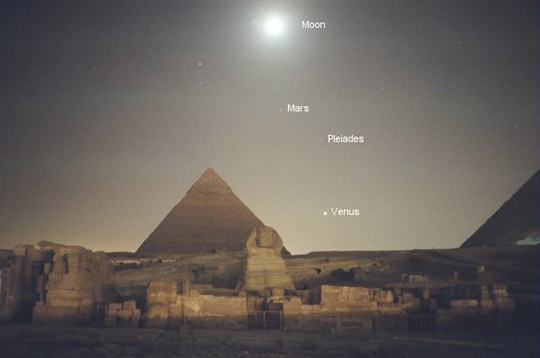
Photo by: Aymen Ibrahem, BA, senior astronomy specialist.
The photo was published in late March 2004 by science@NASA.
Images from spacecraft that orbited the planet and that touched down on its surface showed a fascinating world of amazing terrain and incredible landscape. The images also revealed the sky of Mars is not blue; but, like the surface of the planet, it shows tints of red. The sky of Mars is yellow-brown at noon, and is pinkish at sunset. The skies of Mars feature a curious case of frequent solar eclipses.
Fig (3) The sky of Mars is yellow-brown at noon

Credit: NASA-JPL
Mars has two tiny, irregularly-shaped moons – unlike our Moon, they are not spherical in shape, but rather they look like huge rocks or gigantic potatoes. When the two moons were discovered in 1877, they were so appropriately given the names of the two horses of the chariot of Mars, Phobos (fear) and Deimos (fright).
Fig (4) Phobos, the larger moon of Mars
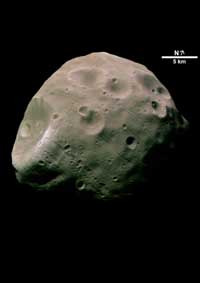
Credit: ESA/DLR/FU Berlin (G. Neukum)
Fig (5) Deimos, the smaller moon of Mars
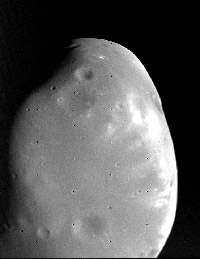
Credit: NASA-GSFC
Phobos and Deimos are among the smallest satellites of the Solar System. Phobos, the larger, is about 22km across, and Deimos is only 12km across. Our Moon is far larger with a diameter of 3,476km. Astronomers even believe Phobos and Deimos are not original satellites of Mars, but rather they could be captured asteroids that fell in the grasp of the planet's gravity.
To an observer on Mars, Phobos would appear to be less than half the apparent size of the Moon, and Deimos would look much smaller, about twice as large as the apparent size of the planet Venus (as seen from Earth).
The two moons are very close to Mars. Phobos is 9,400km from the centre of Mars on average, or less than 6,000km above the surface of Mars. Actually, Phobos is closer to its planet than any other satellite in the Solar System. The average distance of Deimos from Mars is about 2½ times larger than that of Phobos.
The two moons also orbit the planet in very short periods. Phobos orbits Mars in only 7.6 hours, much shorter than the day of Mars (24 hours 37 minutes long). Deimos completes one revolution around Mars every 30.3 hours. Our Moon, whose average distance from the Earth is 384,400km, orbits the Earth once every 656 hours!
Since the average distance of Mars from the Sun is approximately 1.5 times that of the Earth, the Sun appears about 33 % smaller in the skies of Mars. Actually, the Sun was photographed from Mars by several of NASA's space probes.
Fig (6) The apparent size of the Sun as seen from Earth (a) and Mars (b).
Fig (7) Sunset on Mars, imaged by NASA's Mars rover Spirit
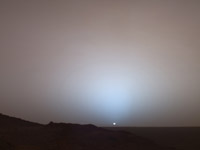
Credit: NASA-JPL
Phobos moves around Mars from west to east, the same direction of our Moon's motion around the Earth, but as the motion of Phobos is much faster than the rotation of the planet, which is also directed from west to east; Phobos rises in the west and sets in the east, taking only 4½ hours to cross the sky. The average duration between two successive risings of Phobos is just over 11 hours, i.e., Phobos rises and sets twice every Martian day!
Deimos moves much slower, and to a Martian observer, it would remain above the horizon for 2½ sols (the day of Mars, whose length is nearly similar to ours, is termed "sol").
The two moons pass between Mars and the Sun so frequently that solar eclipses would not be a rare event to the Martian observer. Phobos eclipses the Sun 1,300 times a year; but the eclipses are so brief, lasting about 20 seconds!
Deimos crosses the disc of the Sun 130 times a year, and each eclipse takes less than 2 minutes. As the apparent size of Deimos is very small, those eclipses look more similar to the transits of Venus than the terrestrial solar eclipses.
Phobos and Deimos also plunge frequently into the shadow of Mars.
As the orbits of Phobos and Deimos lie near the plane of Mars' equator, and due to the proximity of the moons to Mars, Phobos (and its eclipses) cannot be seen above Martian latitude 69º, and Deimos (and its eclipses) cannot be seen above latitude 82 º.
In March 2004, the Martian solar eclipses were actually imaged from the surface of the Red Planet by NASA's twin robotic, six-wheeled Mars Exploration Rovers (MERs).
Fig (8) Solar Eclipses by Phobos and Deimos
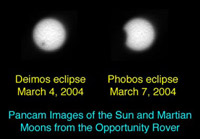
Credit: NASA-JPL
Fig (9) Image sequence of Phobos eclipsing the Sun
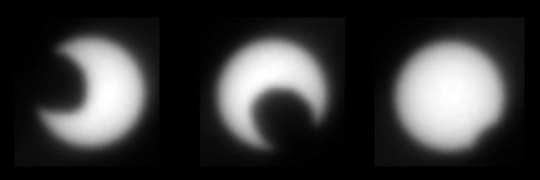
Courtesy: NASA-JPL
Animation: Phobos eclipses the Sun (by the Mars rover Opportunity )
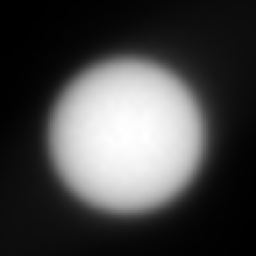
Credit: NASA-JPL
Animation: Deimos eclipses the Sun (recorded by the Mars rover Opportunity )
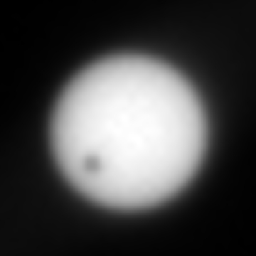
Credit: NASA-JPL
The two Mars rovers, named Spirit and Opportunity, serve as robot geologists; they collect samples from the Martian soil and rocks for analysis, searching for evidence of past liquid water; they also sometimes study the Martian atmospheric phenomena and observe the skies. Each rover is equipped with several cameras that function as the eyes of the rover with which it discovers the Red Planet.
Fig (10) The Mars Exploration Rover
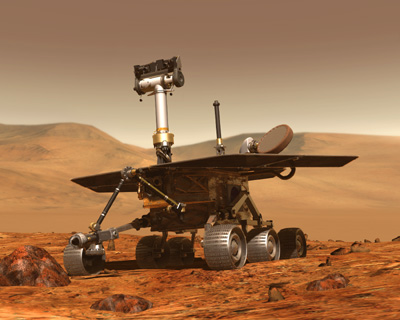
Credit: NASA-JPL
Fig (11) MER studies the rocks of Mars
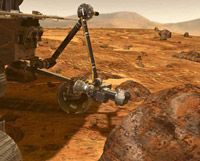
Credit: NASA-JPL
The project scientists commanded the MERs to track the solar eclipses among other celestial phenomena of Mars; and the rover Opportunity imaged a solar eclipse by Deimos on 4 March 2004, and a partial solar eclipse by Phobos three days later.
These eclipse observations are extremely valuable, as the images and timings of the events may help refine the computations of the orbits of the moons.
Previously, the Viking landers imaged the shadow of Phobos moving across the ground, and the Mars Pathfinder spacecraft managed to photograph Phobos emerging at night out of the shadow of Mars, but the MERs were the first Mars explorers to record the Martian solar eclipses.
Interestingly, the orbit of Phobos is decaying; the doomed moon is very slowly spiraling downward to the surface of Mars, and it is expected that within about 50 million years the moon will either crash on the surface of the planet or explode under the tidal forces of Mars forming rings like those of Saturn. So, unfortunately, the future Mars colonists will enjoy the Phobos eclipses for only a limited period!
Further Reading Mars Phobos Deimos Mars Exploration Rovers Mars Pathfinder Missions to Mars Sunset on Mars Solar Eclipses by Mars Moons |
